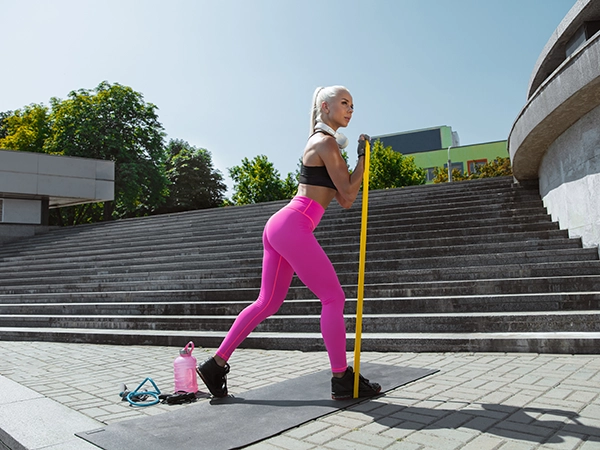Physical Address
304 North Cardinal St.
Dorchester Center, MA 02124
Physical Address
304 North Cardinal St.
Dorchester Center, MA 02124

For many people, the gym can be an intimidating place. Weights clang, grunts echo, and experienced lifters seem to wield barbells like toys. If you’re new to strength training or simply prefer a more low-key workout vibe, you might be wondering: can you actually build muscle with resistance bands?
The answer is a resounding yes! Resistance bands are a fantastic tool for building muscle, and they offer a host of benefits over traditional weights.
Resistance bands. They’re often viewed as the lightweight sidekick to the world of barbells and dumbbells. But don’t be fooled by their unassuming appearance. When used correctly, resistance bands may can be just as effective for building muscle as traditional free weights. In fact, they offer some unique advantages that can make them the perfect tool for anyone looking to get shredded.
Now that you know why resistance bands are awesome, let’s talk about how to use them to build muscle. Here are the key principles.
Resistance bands: those unassuming coils of rubber that might be gathering dust in your gym bag. But don’t underestimate these versatile fitness tools! Resistance bands offer a treasure trove of benefits for people of all ages and fitness levels. Whether you’re a seasoned athlete seeking a new challenge or a beginner dipping your toes into the fitness world, resistance bands can be added your secret weapon to achieving your goals.
Don’t let their unassuming appearance fool you. Resistance bands can provide significant muscle-building and strengthening potential. They offer progressive resistance, meaning the more you stretch the band, the harder it becomes to work against. This continuous challenge forces your muscles to adapt and grow, leading to increased muscle mass and strength gains.
Resistance bands aren’t just for building muscle; they’re fantastic for improving your flexibility and full range of motion. Their gentle, yet effective resistance helps you safely lengthen and loosen your muscles, leading to better joint mobility and a reduced risk of injury. Plus, they’re perfect for dynamic stretches before your workout or static holds to improve your posture.
Unlike bulky gym equipment, resistance bands are incredibly portable and lightweight. Toss them in your gym bag, backpack, or even your purse, and you’ve got a complete workout studio at your fingertips. No more gym memberships or lugging around heavy weights! Resistance bands are also budget-friendly, making them an accessible fitness option for everyone.
Resistance bands aren’t just about biceps curls and squats. They excel at engaging your core and stabilizer muscles, those often-neglected muscles that play a crucial role in balance, stability, and injury prevention. The constant tension and unstable nature of bands force your core to work overtime to maintain proper form, leading to a stronger, more functional physique.
Bored with the same old gym routine? Resistance bands inject a dose of fun and variety into your workouts. With endless exercise possibilities, from lunges and rows to overhead presses and even yoga poses, you can keep your workouts fresh and challenging, preventing boredom and plateaus.
Unlike free weights, which can put stress on your joints, resistance bands offer a gentler form of resistance. The constant tension provides support and stability, making them ideal for people with joint issues, recovering from injuries, or just starting their fitness journey.
Resistance bands are also a staple in rehabilitation and physical therapy programs. Their controlled resistance allows for targeted muscle activation and rehabilitation, helping individuals recover from injuries and improve their overall function.
Muscle hypertrophy, the holy grail of gym rats and fitness enthusiasts alike, refers to the growth and enlargement of muscle mass. It’s the key to that coveted sculpted physique, improved athletic performance, and a confidence boost that radiates from within. But navigating the maze of workout programs can be overwhelming. Fear not, fellow iron warriors! Now we delves into the 4 best muscle hypertrophy workout programs, equipping you with the knowledge to conquer the gym and build the body of your dreams.
This tried-and-true program remains a favorite for its simplicity and effectiveness. It dedicates each workout to specific muscle groups:
This split allows for ample recovery between workouts, maximizing muscle growth. It’s perfect for beginners and intermediates seeking a well-rounded foundation.
This program divides workouts into upper and lower body days, providing greater focus on each muscle group:
This split is ideal for those seeking to prioritize specific muscle groups, like lagging upper body development. It offers more exercise variety compared to the Push-Pull-Legs split, keeping workouts engaging.
This program blends powerlifting principles with high-volume hypertrophy training. It involves:
This program is best suited for intermediate and advanced lifters seeking a blend of strength and size gains. The heavy weights stimulate muscle growth, while the higher-rep days add metabolic stress for additional hypertrophy.
This no-frills program emphasizes progressive overload and mind-muscle connection. It features:
This program is popular among experienced lifters for its focus on muscle activation and building a mind-muscle connection. It’s not for the faint of heart, but can yield impressive results for dedicated individuals.
Can You Build Muscle With Resistance Bands? In conclusion, the journey to building muscle with resistance bands is not only feasible but also rewarding. Their versatility, coupled with the ability to cater to individual fitness goals, makes them a valuable addition to any workout routine. Whether you’re a beginner or a seasoned fitness enthusiast, resistance bands offer a dynamic and effective approach to achie